Behavioral Disorders
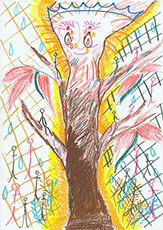

Home | Areas of Application
Behavioral disorders are the most common reasons why parents request a consultation to have their child assessed and evaluated. When a child presents with a behavioral disorder, it is important to address the root cause of their behavior because these imbalances can affect their adult life later on.
Some people can experience complications in their personal and professional life when disrupted behaviors are not treated during childhood: repeated job losses, inability to stabilize their personal relationships.
While it is essential that the child is evaluated and diagnosed by a competent professional, it is equally vital not to identify the child with their diagnosis. We need to remember to first see the child's uniqueness, special talents and vibrancy.
As Bettelheim writes in his book Psychoanalysis of Fairy Tales, "the most important, and also the most difficult task is to help the child to give meaning to their life."
With or without challenges, all children have in common the need to get to know themselves, to better understand the outside world, to understand others and to experience enriching relationships.
CAP offer services to facilitate change in children, teens or adults who are struggling with behavioral issues.
CAP allows for:
CAP takes into account the complex emotional and psychological factors that are involved when a child, teenager or young adult has behavioral problems. Although there is no single factor responsible for a behavioral disorder and the causes are difficult to determine, CAP is an essential step in treatment that will identify the emotional factors associated with these disorders.
In cases where a disorder leads to depression, poor self-image and/or destructive behavior, CAP promotes a healthy expression of emotions. Listening to music and expressing their feeling through drawing is a safe and a meaningful way for people with behavioral issues to connect with their inner essence and creativity.
Instinctively, drawing or painting while listening to music mobilizes different parts of the brain which supports a focus and concentrated behavior.
By discovering, over the course of the sessions, unknown potential, individuals regain their confidence through self-discovery, giving them the ability to communicate more effectively with the world.
Their symptom no longer defines them. They embrace their uniqueness and peculiarities, like many other people.
After this discovery phase, when one finds peace of mind in regaining their confidence, any rehabilitation program which may be implemented during treatment will be more effective because the individual will have a greater understanding of their value.
Feeling secure and confident about yourself and your environment sparks motivation which then becomes a powerful driving force to thrive.
... What I felt in all these drawings was a "spiritual" release (the Chinese, when they get tired of working in their factories, go to these special rooms where they hit with force latex models bearing the image of their boss) .... but as I drew with the music, I really liked it and I hated it at the same time... an interesting case of an undecided and contradictory being. This music, unlike other "picturesque" (sic) music, allows the imagination to unfold on the blank sheet of paper and to draw interesting features from it... ... Seriously, I think it's a good experience to go drawing at least once with this melody which, while keeping the same style, manages to modulate itself, to transmute itself, to pass from imprisonment to freedom (example)." - Thomas, 17-year-old teenager, with difficulties adapting to the school system.
Amandine is a 13-year-old teenager. Apparently illiterate (don't know how to read and write), she had been placed in schools for children with special needs ever since she started school. She was not given a specific diagnosis but was categorized as having low intelligence (mental retardation), unable to access written language and reading.
Amandine, a very suspicious teenager, reacted to the world around her with anger and frustration. When consulting a speech therapist for the first time, her mother expressed helplessness in the face of her daughter's aggressiveness. She fears that she will no longer be able to manage her daughter's behavior.
After a speech-language pathology evaluation and a few therapy sessions, the speech therapist discovers that Amandine is in fact highly intelligent. In an environment where she felt respected, listened to, fully recognized and accepted, she learned quickly and even retained what she learned easily. However, the speech therapist felt from her a strong, pervasive anger within, and before going any further, she suggested CAP. Amandine loved drawing, so it was a good fit.
As the program progressed, the therapist was in awe when she saw Amandine's drawings. They were very expressive, beautiful and poetic.
At the end of the program, Amandine was no longer locked into this image of mental retardation, a diagnosis that she seemed to have accepted, for mysterious reasons, and which were a source of great anger.
"I felt old things within me and misunderstood emotions - I see they are there. I'm a little me, afraid of everything, afraid of the feeling of being small and angry. I felt during the sessions that anger is released, a lot of things when I was little, and I forgot. Now, I have more confidence in myself."
This negative image of herself has been transformed with the CAP sessions. During her speech therapy sessions, Amandine continues to open up and over time is able to master skills in reading and the written language. In the process of incorporating CAP as one of the therapeutic interventions, there is a total transformation. In the following year, she begins to write poems and as she enters a private school, her artistic nature is recognized. Now that she has completed her education, she has become a stylist!

Reference Drawing #1
without music
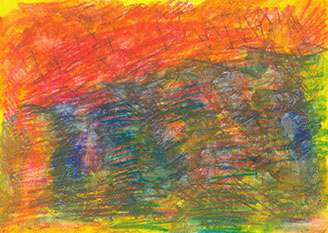
Drawing #1
with music
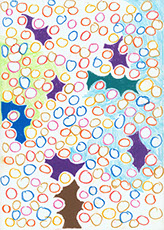
Drawing #2
with music
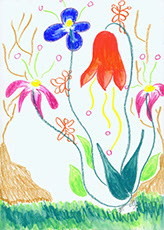
Drawing #3
with music
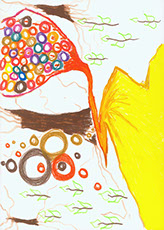
Drawing #4
with music
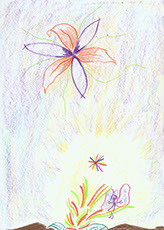
Drawing #5
with music
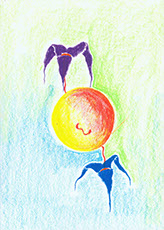
Drawing #6
with music
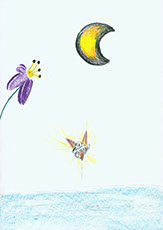
Drawing #7
with music
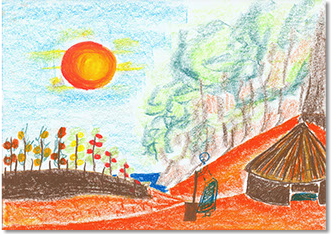
Drawing #8
with music
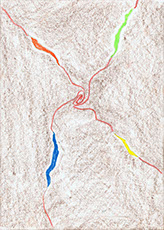
Drawing #9
with music
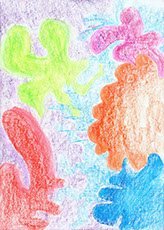
Drawing #10
with music
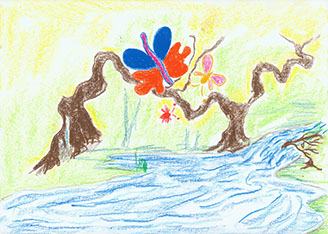
Reference Drawing #2
without music